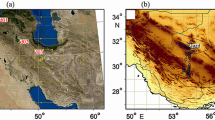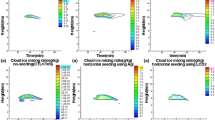Abstract
Successful seeding of clouds in weather modification experiments essentially depends on the seeding time and dynamics, amount of seeding material and location of the initial seeding area. In the present study, we focus on the influence of the initial seeding zone location on the transport of seeding agent material into the target cloud. In addition, the inadvertent transport of seeding material is analysed. During weather modification activities, a lot of seeding material can be transferred far from the seeding zone in a downwind direction. The primary motivation for this research was to prove this statement. We use a three-dimensional, mesoscale cloud-resolving model to achieve our goal. We performed sensitivity tests with respect to the distance between the mass centres of the initial seeding area and the cloud. Different seeding scenarios are analysed. Our principal findings are as follows: (1) For distances between the mass centres of the initial seeding area and the cloud below 2.5 km, all seeding agent material would be activated after a short time. For distances above 10 km, most of the seeding agent would remain inactivated, because horizontal transport of the seeding agent becomes more important than transport induced by the main updraft. For these scenarios, the seeding agent is injected in the cold peripheral part of the cloud. (2) Sensitivity tests show that the inactivated seeding agent would remain close to the seeding area if the seeding is performed below cloud base. This effect occurs even for large distances between the seeding area and the target cloud (>20 km) due to low-level convergence. Thus, this seeding method suppresses the inert seeding material from being transferred far from the seeding zone. (3) The complete seeding material stays inactivated if the seeding is performed between the −8 and −12°C isotherms in front of the increased reflectivity zone. As a consequence, it would be transferred far from its initial area. The cloud would not be able to capture the seeding agent even during its greatest lateral extent.









Similar content being viewed by others
References
Aleksić NM, Farley RD, Orville HD (1989) A numerical cloud model study of the Hallett-Mossop ice multiplication process in strong convection. Atmos Res 23:1–30
Ćurić M (1990) One evidence of the hail suppression efficiency derived from the radar measurements. J Weather Modif 22:79–81
Ćurić M, Janc D (1993) Dependence of the simulated seeding effects of Cb cloud on the types of the AgI agents. Meteorol Atmos Phys 52:91–100
Ćurić M, Janc D (1997) On the sensitivity of hail accretion rates in numerical modeling. Tellus 49A:100–107
Ćurić M, Janc D, Vučković V (1999) Verification of the improved predictive capability of a 1-D forced time-dependent cloud model with truncated hail spectrum. Meteorol Z NF 8:143–154
Ćurić M, Janc D, Vujović D, Vučković V (2003) The effects of a river valley on an isolated cumulonimbus cloud development. Atmos Res 66:123–139
Ćurić M, Janc D, Vučković V (2006) Seeding agent dispersion within convective cloud as simulated by a 3-D numerical model. Meteorol Atmos Phys 92:205–216
Ćurić M, Janc D, Vučković V (2007) Cloud seeding impact on precipitation as revealed by cloud-resolving mesoscale model. Meteorol Atmos Phys 95:179–193
Dessens J (1998) A physical evaluation of a hail suppression project with silver iodide ground burners in southwestern France. J Appl Meteorol 37:1588–1599
Gilmore MS, Steaka J, Rasmussen EN (2004) Precipitation uncertainty due to variations in precipitation particle parameters within a simple microphysics scheme. Mon Weather Rev 132:2610–2627
Grasso LD, Hilgendorf ER (2001) Observations of a severe left-moving thunderstorm. Weather Forecast 16:500–511
Guo X, Zheng G, Jin D (2006) A numerical comparison study of cloud seeding by silver iodide and liquid carbon dioxide. Atmos Res 79:183–226
Levin Z, Krichak SO, Reisen T (1997) Numerical simulation of dispersal of inert seeding material in Israel using a three-dimensional mesoscale model. J Appl Meteorol 36:474–484
Lin Y-L, Farley RD, Orville HD (1983) Bulk parameterization of the snow field in a cloud model. J Appl Meteorol 22:1065–1092
Mather GK, Steffens FE, Fletcher L (1997) Results of the South-African cloud-seeding experiments using hygroscopic flares. J Appl Meteorol 36:1433–1447
Murakami M (1990) Numerical modeling of dynamical and microphysical evolution of an isolated convective cloud—the 19 July 1981 CCOPE cloud. J Meteorol Soc Jpn 68:107–127
Orville HD (1996) A review of cloud modeling in weather modification. Bull Am Meteorol Soc 77:1535–1555
Radinović DJ (1989) Effectiveness of hail control in Serbia. J Weather Modif 21:75–84
Simeonov P (1999) On hail suppression operational results in Bulgaria after some seeding technology change, WMO/TD No. 936. World Meteorological Organization, Geneva, pp 379–382
van den Heever SC, Cotton SC (2004) The impact of hail size on simulated supercell storms. J Atmos Sci 61:1596–1609
Young KC (1996) Weather modification: a theoretician’s viewpoint. Bull Am Meteorol Soc 77:2701–2710
Acknowledgments
This research was supported by the Ministry of Science of Serbia. We gratefully acknowledge the help of Mr Dragomir Bulatović in the technical preparation of the pictures.
Author information
Authors and Affiliations
Corresponding author
Rights and permissions
About this article
Cite this article
Ćurić, M., Janc, D., Vučković, V. et al. An inadvertent transport of the seeding material as a result of cloud modification. Meteorol Atmos Phys 105, 157–165 (2009). https://doi.org/10.1007/s00703-009-0040-9
Received:
Accepted:
Published:
Issue Date:
DOI: https://doi.org/10.1007/s00703-009-0040-9




